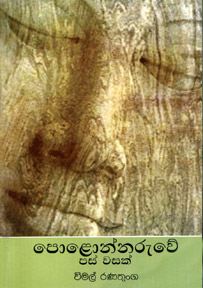Five years in Polonnaruwa: a rediscovery

Travel writing has developed to the extent of extending the mere
barriers of investigative reporting. Places of interest, people of
significance and events of lasting remembrance have always embraced
travel writing. In the compilation of nineteen essays, the Sinhala
journalist Wimal Ranatunga attempts to present a panoramic study of his
experiences in various places in the city of Polonnaruwa.
The book is titled Polonnaruwe Pas Vasak (Five Years in Polonnaruwa,
a Swarnamali Publication). A researcher in the subject area of social
sciences the writer Ranatunga obtained post graduate degrees, which has
led him to involve in intensive studies in the area of Polonnaruwa. A
press officer by profession attached to the Department of Media and
Information, Ranatunga has not been a mere state official, as one notes
under normal conditions.
In a lighter vein he presents the difficulties he had undergone in
order to settle down in a strange place hitherto unknown to him. He
recalls the type of people whom he met and the type of attitude they
had, and finally the human relationships where similarities and
dissimilarities have to be encountered. In this manner, the very first
entry into a historic place of stay, which he had known via textual
readings, becomes a reality. Then he shows how he had to face the
behaviour patterns and linguistic mannerisms of his fellow mates with
whom he had to work with.

|
Discussion of the book
A discussion of Wimal
Ranatungaís Polonnaruwe Pas Vasak will be held at the Sri
Lanka Press Council (Near Mel Medura, Horton Place) on
November 4 at 3.30 pm. Books with the authorís signature
could be obtained for a discount price. |
Once these acquaintances enter oneís lifestyle, it is observed that a
search for a cause becomes an interesting way of discovering aspects of
history, folklore, archaeology, literature and technology. What the
writer Ranatunga tries to presents thus becomes a rediscovery into these
areas of information, which eventually becomes resourceful knowledge. He
is seen taking the reader to such places as Bhuwava, Angammedilla,
Dimbulagala, Kandwarawela, Somavathiya, Giritale and Palligoda, where he
peeps into aspects of known and unknown historic matters. Perhaps the
material laid down may be known by the informants who he had met in the
field. But in the actual presentation of the very same material takes
the shape of a narrative of interesting experience in rediscovery. In
the feature titled as Orubande Siyambalaweve Prema Katha (73pp) the
reader comes to know of a certain king who had met his sweetheart
clandestinely by coming to see her at night.
The place where the king tied his boat on to a tree was later
discovered as a spot where a giant tamarind tree grew. According to
folklore it is a love story of King Mahasena known to people as a
demigod who had resurrected some agrarian matters which resulted in
development.
Yet another interesting legend revolves round an elephant who comes
to worship the Somawathi shrine. The writer in his essay titled
Somavathiya Vandina Aliyek presents how he had travelled to a much
venerated place in order to see to own eyes who an elephant worships the
shrine. The village known as Swarnapaligama is shown as the historic
place where quite a number of significant events took place. It is also
recorded the historical chronicle Mahawamsa. The kingís name
Pandukabhaya is remembered as a person who had undergone much struggle
both with his own relations as well as tribes.
Some of the unknown events linked to the reign of this king is
rediscovered by the writer Ranatunga in the essay titled Pandukabhayata
Swarnapali hamuvu Kalahalga. This essay shuttles from the present to the
past and to various aspects of the events in such places Kalahagoda and
Anmedilla.
Taking a synoptic view, Iím reminded of the tradition of beautiful
writings in the west known by the term belles lettre. The writer
Ranatunga blends information and experiences into an attractive readable
narrative style which overshadows mere reporting. The entire compilation
reminds me of childhood readings of some of the travel writings of D H
Lawrence, as I remember, titled as Sea and Sardinia and Twilight on
Italy.
Travel writings of value could lead to better understandings of
people, places and events enveloped in creative communication. For those
young investigators and discoverers of socio-cultural facets of an
ancient city like Polonnaruwa, the compilation of these 19 essays could
be reckoned as an ideal gift. Many more books of this nature could
elevate the levels of interest in the habits of reading.
The writer too indirectly hints at the lesser degree of value and
interests taken on the part of the conventional type of administrators
appointed by the state to look after social matters relating fauna,
flora and humans living in these areas. He in subtle dialogues and
monologues create a certain sense of human on the ignorance on the part
of the caretakers as versus real owners.
[email protected]
|



